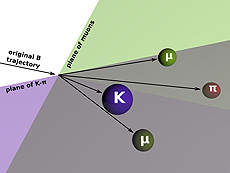The geometry of particle decays
 |
The decay pictured above results in two pairs of particles: a kaon with a pion and two muons. There is a lot of information in the opening angle of each pair and in the angle between the planes that pass through each pair. |
Many of the analyses we present in these columns are fundamentally simple. The experiments are difficult to perform, requiring record-setting beam energies, magnetic fields, computing resources and a lot of hard work, but the goal is easy to explain: find the new particle or prove that it does not exist.
In this article, I'd like to present one of the more subtle analyses, a study of angular distributions from a chain of particle decays. The particles involved are well-known, and the decay (a B meson to an excited kaon and two muons) was first observed 10 years ago. What makes this analysis interesting is that there is so much information in the trajectories of the final particles. Undiscovered physics, such as supersymmetry, could influence the way that the B meson disintegrates, resulting in a modified pattern of particle trajectories. Without paying close attention to these distributions, scientists could miss an important hint of the exotic hiding in the mundane.
Precision measurements are further complicated by the fact that particles decay with random trajectories, like fireworks. But even fireworks have patterns and structure. A firework that explodes from a stand-still bursts symmetrically, like a rose, while a firework that explodes while still rocketing upward results in a funnel of final particle trajectories. With a careful record of a hundred random fireworks, you could learn a lot about their internal dynamics.
The fireworks analogy would be directly applicable to inferring a particle's mass from its decay, but a recent paper from CMS studies two additional influences on the shape of the decay. One is the polarization of the excited kaon. In much the same way that light can be polarized horizontally or vertically, particles can be polarized, and the polarization of a decaying particle determines how well its remnants align (on average) with its original axis of motion. Another is the forward-backward asymmetry of the muons: how often they continue in the direction of motion of the B meson and how often they fly backward.
This particular decay has four final state particles (the excited kaon decays into a charged kaon and a pion, plus the two muons makes four), and all of the effects described above are happening simultaneously, with some randomness sprinkled in. Nature would be truly devious to hide evidence of a profound discovery in such a complicated setting, but this has never stopped her before.
—Jim Pivarski
 |
The physicists pictured above performed this analysis of angular distributions in B0 to K0*, μ, μ. |
 |
Sonya Wright has joined the team of administrative professionals who ensure that the CMS Center and the LHC Physics Center operate smoothly. |
|